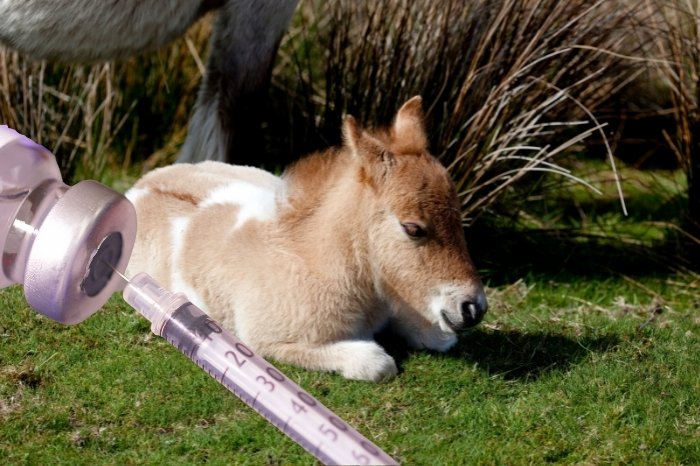Last Updated on August 18, 2022
Many equine enthusiasts may have never come across white muscle disease in horses, but it is important to understand the mechanism behind this complex medical disorder. Let’s find out everything you need to know about white muscle disease in horses!
What Is White Muscle Disease In Horses?
White muscle disease, more correctly known as nutritional myodgeneration (NMD), is a disorder that is most common in newborn foals. NMD normally occurs when the foal does not receive enough selenium from its mother.
As the broodmare grazes, the grass she eats contains a wide range of vitamins and minerals, one of which is selenium. As the foal receives all of its nutrition from the dam both before and after birth, it is completely reliant on the mother to provide all the nutrition it needs.
Unfortunately, in large areas of the US, grazing land does not contain sufficient levels of selenium. Plants and grasses take up selenium through their roots, from the groundwater and soil. If the dam cannot get enough selenium in her diet, she cannot then provide her foal with enough selenium.
Click Here to Get Info About:
What Are The Signs Of White Muscle Disease In Horses?
Selenium is vital for newborn foals as it is an essential trace mineral that provides important antioxidant functions. When a foal is deficient in selenium, the main body system affected is the muscular system. These foals also often have a rapid, irregular heartbeat.
Muscle cells will start to degenerate, and skeletal muscle turns paler in color – this is where the name ‘white muscle disease’ comes from. These foals are normally weak at birth, and show signs of stiffness due to myopathy of the muscles. They can show clinical signs such as trembling and difficulty standing.
Foals with white muscle disease exhibit a classic set of symptoms, including difficult swallowing and respiratory distress. This puts them at increased risk of aspiration pneumonia, as they are unable to nurse from the dam correctly. The breathing difficulties can lead to respiratory failure and death.
How Is White Muscle Disease In Horses Diagnosed?
Diagnosis of white muscle disease in horses is relatively simple. Your veterinarian will take a blood sample, and check levels of selenium and vitamin E – if these are low, then NMD is highly likely. They will also test the muscle enzymes in the blood, which will indicate the severity of the disease and the extent of the muscular damage.
If a foal dies unexpectedly or during treatment for NMD, a post-mortem examination will show skeletal muscle that is pale or even completely white in color.
Horse Health Vita E & Selenium Crumbles Horse Vitamin Supplement
How Is White Muscle Disease In Horses Treated?
When a foal is diagnosed with white muscle disease, your veterinarian will normally immediately start a course of intramuscular selenium injections. If vitamin E levels were shown to be low on the blood tests, an oral vitamin E supplement will also be given.
It can take time to restore the levels of selenium and vitamin E to their correct levels, so it is normally necessary to give the foal supportive treatment at the same time. This will normally include monitoring and regulating the foal’s fluid balance, by administering intravenous fluids or oral electrolytes. If the foal has respiratory problems or secondary aspiration pneumonia, antibiotics will commonly be administered.
Foals with white muscle disease are often weak and unable to stand for long periods. In this situation, it is normally preferable to hospitalize the foal in a specialist equine veterinary clinic so the appropriate care can be provided.
The foal will need to be provided with a deep soft bed that is kept clean and dry at all times. It will also be necessary to assist the foal to stand and turn it over at regular intervals to prevent the development of ulcers and skin sores.
A foal that is unable to nurse properly due to weakness or difficulty swallowing may need to be fed from a bottle or via a nasogastric tube. The dam should be kept nearby to help maintain the bond between mare and foal.
Foals that receive a prompt diagnosis and swift treatment for white muscle disease normally make a full recovery. If the disease has progressed to the point where the cardiac muscle is affected, the prognosis is much poorer and the foal may not survive.

Summary – White Muscle Disease In Horses
So, as we have learned, white muscle diseases in horses occur mainly in newborn foals when they do not receive enough selenium from their mother. Foals with white muscle disease have symptoms including difficulty swallowing and respiratory distress, putting them at increased risk of aspiration pneumonia. A blood test can be used to diagnose white muscle disease in foals, and treatment includes selenium injections and supportive therapies such as intravenous fluids and electrolytes.
We’d love to hear your thoughts on white muscle disease in horses! Have you ever had a horse diagnosed with this complex medical condition? Or maybe you’ve got some questions about the best way to prevent white muscle disease in your foal? Leave a comment below and we’ll get back to you!
FAQ’s

Kate Chalmers is a qualified veterinary nurse who has specialized in horse care for the vast majority of her career. She has been around horses since she was a child, starting out riding ponies and helping out at the local stables before going on to college to study Horse Care & Management. She has backed and trained many horses during her lifetime and competed in various equestrian sports at different levels.
After Kate qualified as a veterinary nurse, she provided nursing care to the patients of a large equine veterinary hospital for many years. She then went on to teach horse care and veterinary nursing at one of the top colleges in the country. This has led to an in-depth knowledge of the care needs of horses and their various medical ailments, as well as a life-long passion for educating horse owners on how to provide the best possible care for their four-legged friends.
Kate Chalmers BSc (Hons) CVN, Dip AVN (Equine) Dip HE CVN EVN VN A1 PGCE


